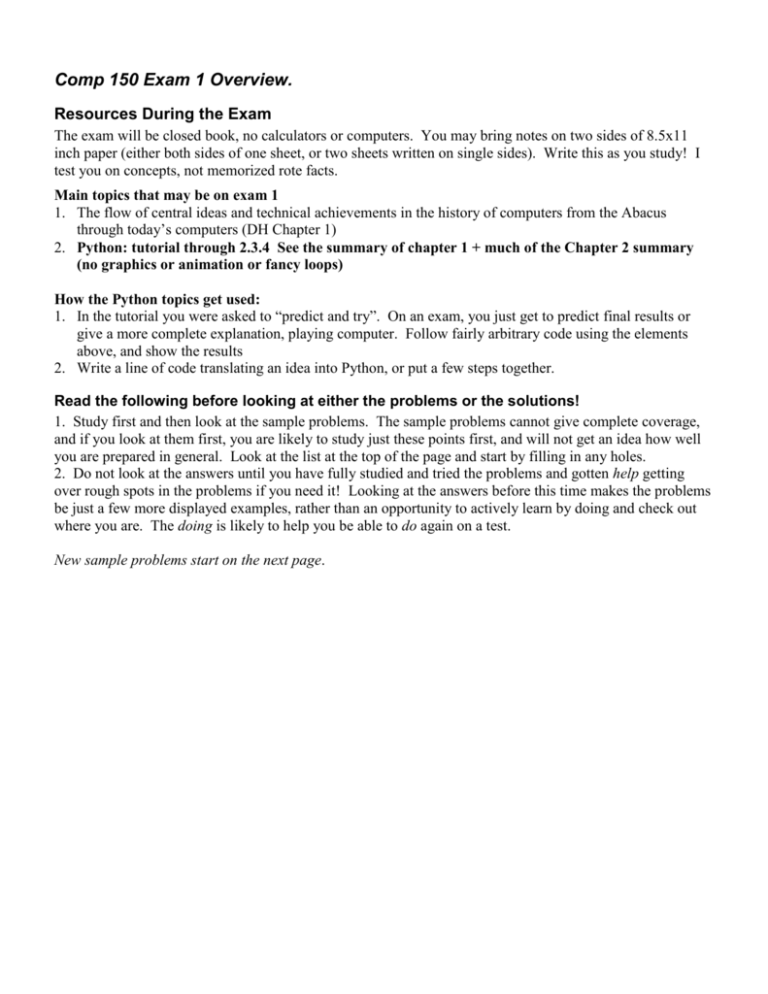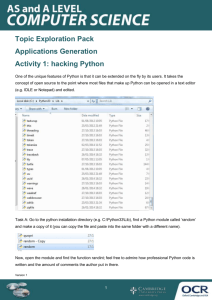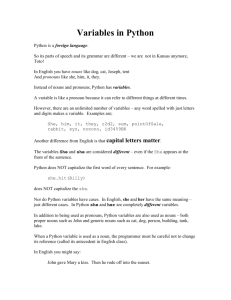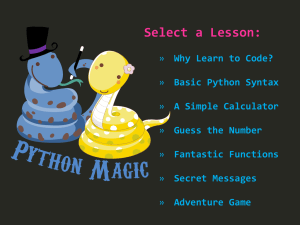Comp 150 Exam 1 Overview
advertisement

Comp 150 Exam 1 Overview.
Resources During the Exam
The exam will be closed book, no calculators or computers. You may bring notes on two sides of 8.5x11
inch paper (either both sides of one sheet, or two sheets written on single sides). Write this as you study! I
test you on concepts, not memorized rote facts.
Main topics that may be on exam 1
1. The flow of central ideas and technical achievements in the history of computers from the Abacus
through today’s computers (DH Chapter 1)
2. Python: tutorial through 2.3.4 See the summary of chapter 1 + much of the Chapter 2 summary
(no graphics or animation or fancy loops)
How the Python topics get used:
1. In the tutorial you were asked to “predict and try”. On an exam, you just get to predict final results or
give a more complete explanation, playing computer. Follow fairly arbitrary code using the elements
above, and show the results
2. Write a line of code translating an idea into Python, or put a few steps together.
Read the following before looking at either the problems or the solutions!
1. Study first and then look at the sample problems. The sample problems cannot give complete coverage,
and if you look at them first, you are likely to study just these points first, and will not get an idea how well
you are prepared in general. Look at the list at the top of the page and start by filling in any holes.
2. Do not look at the answers until you have fully studied and tried the problems and gotten help getting
over rough spots in the problems if you need it! Looking at the answers before this time makes the problems
be just a few more displayed examples, rather than an opportunity to actively learn by doing and check out
where you are. The doing is likely to help you be able to do again on a test.
New sample problems start on the next page.
Review Problems for Exam 1 (Solutions follow the problems.)
1. What is printed by the Python code?
x = 5
y = x + 3
x = x - 1
z = 10
x = x + z
print ’x: %s, y: %s, z: %s’ % (x, y, z)
2. What is printed by the Python code?
print 14/4, 14%4, 14.0/4
3. What is printed by the Python code?
print 2*'No' + 3*'!'
print 2 * ('No' + 3*'!')
5. What is printed by the Python code?
name = 'Stanley'
print name[1], name[3:5]
6. What is printed by the Python code?
for z in [2, 4, 7, 9]:
print z - 1
4. What is printed by the Python code?
print '2' + '3'
7. What is printed by the Python code?
x = 2.5679
y = 9.0
print ”Answers %.3f and %.3f” % (x, y)
8. What is printed by the Python code?
def func():
print 'Hi'
print 'Lo'
func()
9. What is printed by the Python code?
def func(x):
print 2*x
func(5)
func(4)
10. What is printed by the Python code?
def func(x):
return x - 1
print func(3) + func(5)
11. What is printed by the Python code?
n = 3
for x in [2, 5, 8]:
n = n + x
print n
12. What is printed by the Python code?
print range(3)
13. What is printed by the Python code?
for i in range(3):
print 'Hello again!'
14. What is printed by the Python code?
for i in range(4):
print i
15. What is printed by the Python code?
s = 'abcde'
for i in range(3):
print s[i]
16. What is printed by the Python code?
nums = list()
for i in range(4):
nums.append(2*i)
print nums
17. What is printed by the Python code?
s = 'I ate it.'
print s.upper()
print s.count('t')
w = s.split()
print w
print '/'.join(w)
18. The data crunching needs of the 1890 US census were addressed by what development significant in the
history of computers?
19. In modern computers, numbers are stored electronically. Earlier mechanical devices used for numerical
calculation had other ways of representing numbers. List two ways.
20. Write a Python program that prompts the user for two numbers, reads them in, and prints out the product,
labeled.
21. Given a string s, write a short expression for a string that includes s repeated five times.
22. Suppose you know x is an integer and ys is a string representing an integer. For instance, x is 3 and ys
is '24'. Write code to print out the arithmetic sum of the two. In the example case, 27 would be
printed.
23. Suppose you are given a list of words, wordList. Write Python code that will write one line for each
word, repeating that word twice. For example if wordList is ['Jose', 'Sue', 'Ivan'], then
your code would print
Jose Jose
Sue Sue
Ivan Ivan
24. Write code to create a Python dictionary (the dict type). Add two entries to the dictionary: Associate the
key ‘name’ with the value ‘Juan’, and associate the key ‘phone’ with ‘508-1234’
25.
Complete the code for the following function so it matches its documentation:
def doubleList(numberList):
''' For each of the numbers in the list numberList, print a line
containing twice the original number. For example,
doubleList([3, 1, 5]) would print
6
2
10
'''
Answers on the next page
Exam 1 Review Problem Answers
1.
x: 14, y: 8, z: 10
2.
3 2 3.5
3.
NoNo!!!
No!!!No!!!
4.
5.
6.
1
3
6
8
23
t nl
7. Answers 2.568 and 9.000
8.
Lo
Hi
10. 6
11. 18 # 3+2+5+8
12 [0, 1, 2]
13.
Hello again!
Hello again!
Hello again!
14.
0
1
2
3
15.
a
b
c
16.
[0, 2, 4, 6]
17.
I ATE IT.
9.
2
10
['I', 'ate', 'it.']
8
I/ate/it.
18. A machine invented by Hollerith was used to tabulate the results, that added up data coded on punched
cards.
19. Punched cards as above, the angle of gears or knobs (like in old odometers or the Difference Engine),
and another choice mentioned briefly in the introduction is the position of beads in an abacus.
20.
x = input(”Enter a number: ”)
# or some such prompt
y = input(”Enter another number: ”) # or some such prompt
print ”The product is ”, x*y
# or some such label
24.
21. s*5
# or:
s+s+s+s+s
d = dict()
22. print x + int(ys)
d['name'] = 'Juan'
23. for word in wordlist:
d['phone'] = '508-1234'
print word, word
25.
def doubleList(numberList):
''' For each of the numbers in the list numberList, print a line
containing twice the original number. For example,
doubleList([3, 1, 5]) would print
6
2
10
'''
for n in numberList:
print 2*n







